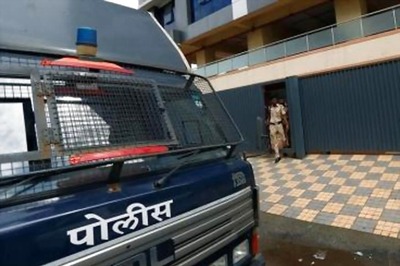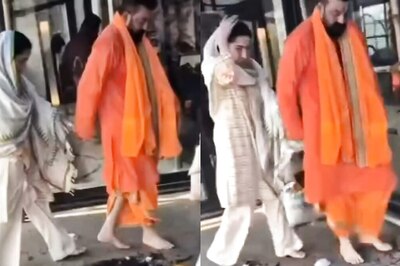
views
Earlier this week, the Indian National Congress reconstituted its Working Committee. At the top of this list were former Prime Minister Dr Manmohan Singh, Sonia Gandhi and Rahul Gandhi – while the former two jointly spearheaded the country between 2004 and 2014, also infamously known as ‘India’s Lost Decade’, Rahul made his first parliamentary appearance in 2004. The Manmohan-Sonia era which lasted for two tenures, with Rahul in the ‘trainee’ seat, saw scams worth Rs 12 lakh crore i.e. Rs 12,00,00,00,00,00,000. These are not just zeroes on paper, this is India’s taxpayers’ money which was siphoned off into private kitties.
The list of scams is long and truly painful to see, but even more disturbing is the nonchalance with which processes were discarded and transparency in following established systems for procurement and allotment was completely ignored, over and over again. However distressing, we must endure and recollect the top financial scams of the era that set the country back several decades – 2G spectrum, Satyam, Adarsh Housing Society, Coal, Commonwealth, Tatra Truck, cash for votes, National Herald, DLF, fodder, Ghaziabad Provident Fund, IPL, and many more.
THE MANMOHAN-SONIA ERA
Gandhi, who had stated that she listened to her inner voice to give up the post of the prime minister and nominated Dr Singh instead, remained very much a power centre. She bypassed constitutional processes and the Prime Minister’s Office (PMO) when it came to policy-making, procurements, allocations, selection of bureaucrats and ministers. A standout example was the creation of the National Advisory Council (NAC), for which she hand-picked members, left Dr Singh out, chaired it herself and made decisions which the United Progressive Alliance (UPA) government had to implement. An unconstitutional body such as the NAC provided unhinged power to its members to make decisions which would be subject to zero accountability. It became a “politically fatal combination”, as described by Dr Singh’s PMO official, further adding that “responsibility without power and governance without authority meant that Dr Singh was unable, even when he was aware, to check corruption in his ministry to avoid disturbing the political arrangement over which he nominally presided”. As a result, he wasn’t able to dismiss ministers at will.
The other problem was Gandhi’s personal branding exercise which continued aggressively – according to insiders, “she would take credit for all the good work, project herself as the caring socialist concerned about the welfare of the poor, while all the blame for any mistake or failure would go to Dr Singh”.
SONIA LOYALISTS
Gandhi’s disdain for abject poverty in India, in contrast to her high European taste, is well-known to the Delhi durbari circles. Journalistic accounts are telling of her personality. Tavleen Singh has written about an episode when Gandhi visited a village and saw a baby crawling around a pile of cow dung. He was playing with it and putting it in his mouth. The filth appalled her.
Gandhi, however, found a way to ignore the Indian reality, of how the Congress, specifically the family she got married into, had left the poor of the country. Instead of vowing to make a change, she allegedly chose to spend time on decorating her house and curating a social group apt for her taste.
Intimate members of this social group were the Quattrocchi couple – husband Ottavio was alleged to be the middleman in the Bofors deal, which the Gandhi family went to great lengths to cover up. The Quattrocchis were so close to Gandhi and Rahul that at one point Mrs Quattrocchi kicked a security guard at 7 Race Course Road for trying to use a metal detector on her.
Even after Dr Singh took over, Gandhi harboured and protected her loyalists. She continued to bypass and avoid constitutional processes to save them – many of whom she even placed in the NAC. Lobbyists and middlemen thrived during the UPA era, many of whom became power-brokers for folks trying to negotiate their way into the Union Cabinet. Even after a scam was exposed by the media, Dr Singh’s UPA government tried to minimise the damage to the loyalist concerned for as long as possible.
As we inch closer to the 2024 General Elections, it may be time to give this contrast some deep thought — Has the stern, corruption-free governance of Prime Minister Narendra Modi made us forget the misdeeds and loot of the UPA government? Have we forgotten the point of desperation and despair that the country was driven to at the end of the UPA’s second term? Perhaps, it may be time to dig out those old stories and refresh the horrific memories.
This is Part V of a multi-part series. A look at the other parts:
Part I: Opinion | Indian Prime Ministers and Cases of Corruption: Rajiv Gandhi’s Indefensible Defence Deals
Part II: Opinion | Indian Prime Ministers and Cases of Corruption: Nehru and the Birth of Scams
Part III: Opinion | Indian Prime Ministers and Cases of Corruption: Indira’s Biggest Racket — ‘Garibi Hatao’
Part IV: Opinion | Indian Prime Ministers and Cases of Corruption: Indira’s Dhritrashtra Syndrome & Emergency Excesses
Priyam Gandhi-Mody is an author of three bestselling books, including ‘A Nation to Protect’. Her fourth book is expected to be released in October 2023. Views expressed in the above piece are personal and solely that of the author. They do not necessarily reflect News18’s views.


















Comments
0 comment